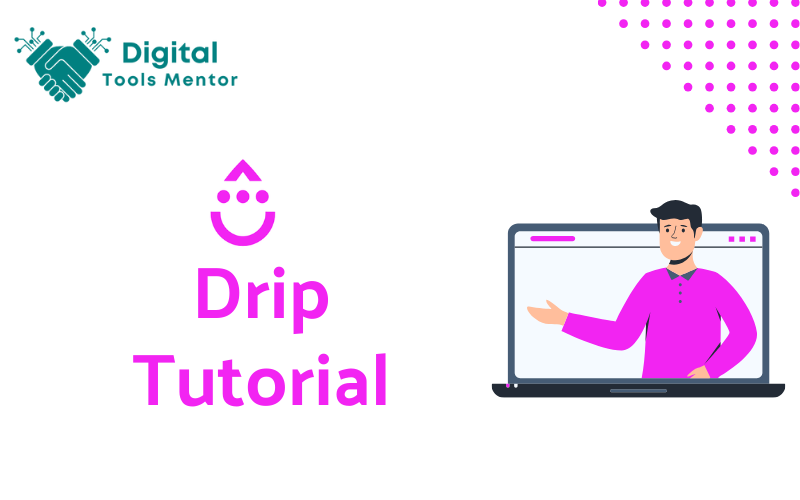Drip Tutorial 2025
As we step into 2025, Drip emerges as an increasingly crucial tool in the realm of automated email marketing. Drip is not just another email marketing platform; it’s a sophisticated system designed to nurture leads, engage customers, and drive conversions through targeted, automated email sequences. With its advanced automation capabilities, personalized content delivery, and robust analytics, Drip stands out as a key player in the modern marketer’s toolkit, especially in an era where personalization and automation are not just nice-to-haves but necessities. This comprehensive Drip Tutorial is designed to walk you through the intricacies of Drip, from the ground up. Whether you’re a complete beginner or looking to enhance your existing knowledge, this tutorial will provide valuable insights into making the most out of Drip’s features. We’ll cover everything from setting up your Drip account and creating your first email campaign to advanced segmentation, personalization strategies, and integrating Drip with other tools and platforms. Additionally, we will delve into analyzing and optimizing your email campaigns using Drip’s in-depth analytics tools.
By the end of this guide, you can expect to have a thorough understanding of how to effectively use Drip for your email marketing needs in 2025. Our goal is to equip you with the knowledge and skills needed to craft compelling automated email campaigns that resonate with your audience, drive engagement, and ultimately contribute to your business’s growth and success. So, let’s embark on this journey to master Drip and unlock its full potential in your email marketing endeavors.
Getting Started with Drip
Embarking on your journey with Drip, a powerful email marketing and automation tool, begins with understanding how to sign up, set up your account, and navigate its features. Drip’s intuitive interface and advanced functionalities make it a preferred choice for many marketers in 2025. Here’s a guide to help you get started.
How to Sign Up and Set Up a Drip Account
- Creating a Drip Account:
- Visit the Drip website and click on the ‘Sign Up’ button.
- You’ll be prompted to enter basic information such as your name, email address, and a password.
- Depending on your business type, you might also be asked to provide additional details like your website URL and company size.
- Choosing a Plan:
- Drip offers various pricing plans tailored to different business needs and sizes. Select a plan that suits your requirements, considering factors like the number of subscribers and the level of functionalities you need.
- Most plans come with a free trial period, allowing you to explore Drip’s features before making a financial commitment.
- Account Verification and Setup:
- After signing up, verify your account through the confirmation email sent to your registered email address.
- Once verified, log in to your account and complete the setup process, which may include configuring settings such as your time zone, currency, and email sending preferences.
Navigating the Drip Dashboard: Key Features and Tools
- Dashboard Overview:
- The Drip dashboard provides a centralized view of your campaigns, subscriber activities, and key metrics. Familiarize yourself with the dashboard layout to access these insights quickly.
- Main Sections:
- Campaigns: Manage and create your email campaigns from here.
- Subscribers: View and manage your subscriber list, including adding or importing new subscribers.
- Analytics: Access detailed reports on your campaign performance, subscriber growth, and engagement metrics.
- Automation: This is where you can create and manage workflows, rules, and triggers for automated email sequences.
Understanding Drip’s Interface and Basic Functionalities
- Workflow Creation:
- Drip’s powerful workflow feature allows you to create automated email sequences based on specific triggers and actions, such as when someone subscribes to your list or makes a purchase.
- Email Template Design:
- Utilize Drip’s email template editor to design engaging and responsive emails. The platform offers a range of customizable templates to suit various campaign needs.
- Subscriber Management:
- Learn how to add and segment subscribers. Drip allows detailed segmentation based on subscriber behavior, purchase history, and engagement levels, enabling targeted and personalized email campaigns.
- Integration Capabilities:
- Explore how to integrate Drip with other tools and platforms you may be using, such as CRM systems, e-commerce platforms, and social media channels, to streamline your marketing efforts.
Getting started with Drip is the first step in leveraging its comprehensive email marketing and automation capabilities. By familiarizing yourself with how to set up your account, navigate the dashboard, and understand its key functionalities, you’ll be well on your way to executing effective and automated email marketing campaigns that resonate with your audience and drive results.
Creating Your First Drip Campaign
Launching your first campaign in Drip is a pivotal step in harnessing the power of email marketing. Drip campaigns are automated sets of emails sent out based on specific timelines or user actions. Here’s a step-by-step guide to setting up your campaign, designing effective workflows, and writing content that engages and converts.
Step-by-Step Instructions on Setting Up a Drip Campaign
- Define Your Campaign Goals:
- Before setting up the campaign, clearly define what you want to achieve. Are you looking to nurture leads, onboard new customers, or promote a new product?
- Create a New Campaign:
- In Drip, go to the ‘Campaigns’ section and select ‘New Campaign’. Give your campaign a meaningful name that reflects its purpose.
- Select the Trigger for Your Campaign:
- Choose the trigger that will start your campaign. This could be when a user subscribes to your list, makes a purchase, or any other action relevant to your goal.
- Design Your Email Sequence:
- Plan the number of emails in your campaign and the time interval between them. For instance, if it’s a welcome series, you might want to send a few emails over the first few weeks of a subscriber joining your list.
- Craft Your Emails:
- Write the content for each email in your sequence. Ensure that each email aligns with your overall campaign goals and offers value to the recipient.
- Test and Activate Your Campaign:
- Before going live, test your email sequence to check for any errors or issues. Once satisfied, activate your campaign.
Designing Effective Email Workflows
- Understand Your Audience’s Journey:
- Map out your customer journey and design your email workflow to align with this journey. Each email should logically lead to the next step in the sequence.
- Use Conditional Logic:
- Drip allows for conditional logic in workflows. Use this to create different paths in your campaign based on how subscribers interact with your emails.
- Monitor and Optimize the Workflow:
- Regularly review the performance of your email sequence and make adjustments as needed. This could involve changing the timing of emails, tweaking the content, or altering the workflow based on subscriber actions.
Tips for Writing Engaging and Impactful Email Content in Drip
- Personalize Your Content:
- Use personalization tokens to address subscribers by name or include other relevant personal details. Personalization can significantly increase engagement rates.
- Write Clear and Compelling Subject Lines:
- Your subject line is the first thing subscribers see. Make it clear, engaging, and relevant to the content of the email.
- Keep Your Content Focused and Valuable:
- Each email should have a clear focus and provide value to the recipient. Avoid cluttering your emails with too many messages or calls to action.
- Include Strong Calls to Action:
- Your emails should guide subscribers to the next step, whether it’s reading a blog post, checking out a new product, or another call to action.
- Optimize for Mobile:
- Ensure your emails are mobile-friendly, as many users will read them on mobile devices.
Creating your first drip campaign in Drip is about more than just sending emails; it’s about creating a strategic, automated communication flow that nurtures your relationship with your subscribers. By following these steps and tips, you can set up a campaign that not only resonates with your audience but also drives your desired outcomes.
Segmenting Your Audience in Drip
Effective audience segmentation is key to the success of email marketing campaigns, especially in a platform as robust as Drip. Segmenting your audience allows you to send targeted, relevant content to different groups within your email list, improving engagement and conversion rates. Here’s how to best segment your audience in Drip and use its features to enhance your email campaigns.
Best Practices for Segmenting Your Email List
- Identify Segmentation Criteria:
- Determine the factors for segmenting your audience. This could be based on demographics, purchase history, engagement level, website behavior, or other relevant criteria.
- Understand Your Audience:
- Develop a deep understanding of your audience’s needs, preferences, and behavior. This understanding will guide your segmentation strategy.
- Keep Segments Manageable:
- While it’s tempting to create many specific segments, it’s more effective to keep them manageable and meaningful. Too many segments can complicate your email strategy and dilute your messaging.
- Regularly Review and Update Segments:
- Audience interests and behaviors can change over time. Regularly review and update your segments to ensure they remain relevant.
Utilizing Drip’s Segmentation Features for Targeted Campaigns
- Use Tags and Custom Fields:
- Drip allows you to tag subscribers based on their actions or behaviors. Use tags and custom fields to create detailed segments.
- Leverage Behavioral Data:
- Utilize data on subscriber interactions with your emails and website. Drip tracks actions like email opens, clicks, and website visits, which can be powerful segmentation criteria.
- Dynamic Segmentation:
- Drip supports dynamic segmentation, where subscribers are automatically added or removed from segments based on their actions. This keeps your segments up-to-date and relevant.
Strategies for Effective Audience Segmentation
- Create Buyer Personas:
- Develop buyer personas representing different segments of your audience. Tailor your content and campaigns to these personas for more targeted marketing.
- Segment by Engagement Level:
- Create segments based on how subscribers engage with your emails, such as active, inactive, or highly engaged subscribers. This allows for targeted re-engagement strategies and more personalized content.
- Use Segmentation for Personalization:
- Go beyond basic personalization like using the subscriber’s name. Tailor the content of your emails to the interests and needs of each segment.
- Test and Optimize Segments:
- Continuously test and analyze the performance of your segmented campaigns. Use insights from these analyses to refine your segmentation strategy.
- Ensure Compliance with Privacy Laws:
- When segmenting your audience, ensure that you comply with privacy laws like GDPR. Be transparent about how you collect and use subscriber data.
Effective segmentation in Drip enables you to send the right message to the right people at the right time. By understanding your audience and utilizing Drip’s advanced segmentation features, you can create more relevant, engaging, and successful email marketing campaigns. Remember, the goal of segmentation is to enhance the personalization and relevance of your communication, ultimately leading to stronger relationships with your subscribers and better campaign results.
Personalizing Your Drip Campaigns
In the world of email marketing, personalization is key to creating meaningful connections with your audience. Drip’s personalization features allow you to tailor your email campaigns to meet the specific needs and interests of different audience segments, thereby enhancing engagement and conversion rates. Here’s how to effectively use Drip’s personalization features, create personalized content, and employ techniques to boost engagement.
How to Use Drip’s Personalization Features
- Custom Fields for Personalization:
- Drip allows you to create custom fields to store specific information about your subscribers, such as their name, location, or purchase history. Use these fields to personalize your emails by including the subscriber’s name or referencing their past interactions with your brand.
- Utilizing Tags for Dynamic Content:
- Tags in Drip can be used to segment your audience based on their behaviors, such as website visits, product purchases, or engagement levels. Use these tags to send dynamic content that resonates with each segment’s interests and behaviors.
- Using Liquid Templating for Advanced Personalization:
- Drip supports Liquid templating language, which allows for advanced personalization options. With Liquid, you can display different content to different subscribers based on the data stored in their subscriber profile.
Creating Personalized Content for Different Audience Segments
- Segment-Specific Email Campaigns:
- Create separate email campaigns for different segments of your audience. For instance, send different product recommendations to new customers versus repeat customers.
- Tailoring the Email’s Tone and Messaging:
- Adjust the tone, style, and messaging of your emails to match the preferences and expectations of each segment. This could involve changing the language style or focusing on different product features.
- Personalized Product Recommendations:
- Use your subscribers’ purchase history and browsing behavior to make personalized product or content recommendations.
Techniques for Increasing Engagement Through Personalization
- A/B Testing Personalized Elements:
- Conduct A/B tests on different personalization elements of your emails, such as personalized subject lines, greetings, or product recommendations, to determine what works best.
- Behavior-Based Email Triggers:
- Set up email triggers based on subscriber actions. For example, send a personalized email when a subscriber abandons their cart or visits a specific page on your website.
- Personalized Re-Engagement Campaigns:
- Create personalized re-engagement campaigns for subscribers who haven’t interacted with your emails for a while. Tailor the content to reignite their interest.
- Celebrating Milestones:
- Use personalization to celebrate subscriber milestones, like the anniversary of their first purchase or their birthday, with personalized offers or messages.
- Feedback and Surveys:
- Send personalized emails asking for feedback or conducting surveys. This not only provides valuable insights but also makes subscribers feel valued and heard.
Personalizing your Drip campaigns can significantly improve your email marketing performance by making each subscriber feel uniquely catered to and understood. By leveraging Drip’s personalization features and employing strategic techniques, you can enhance subscriber engagement, build stronger relationships, and drive more meaningful results from your email marketing efforts.
Advanced Automation Features
Drip’s advanced automation capabilities are a game-changer in email marketing, allowing marketers to create sophisticated, highly effective campaigns. By setting up complex triggers and actions and integrating automation with personalization, you can significantly enhance the impact of your marketing efforts. Let’s explore how to leverage these advanced features in Drip for maximum impact.
Exploring Drip’s Advanced Automation Capabilities
- Workflow Automation:
- Drip’s workflow automation feature enables you to design a sequence of automated actions based on specific triggers. This can include sending a series of emails, applying tags, or moving subscribers between segments based on their behavior.
- Event-Triggered Emails:
- Set up emails that are triggered by specific events, such as a subscriber making a purchase, visiting a particular page on your website, or engaging with a previous email.
- Conditional Logic in Workflows:
- Use conditional logic to create more complex and tailored workflows. This allows different actions to occur based on specific conditions or subscriber attributes, leading to more personalized and relevant marketing interactions.
Setting Up Complex Triggers and Actions for Sophisticated Marketing Funnels
- Identifying Key Triggers:
- Determine the key behaviors or actions that will trigger your automated workflows. This could be anything from a subscriber joining your email list to them engaging with a particular piece of content.
- Designing Multi-Step Workflows:
- Create multi-step workflows that guide your subscribers through a marketing funnel. For example, start with a welcome email, followed by educational content, and then lead to a sales pitch.
- Using Tags and Lead Scoring:
- Implement tags and lead scoring within your workflows to segment and prioritize subscribers based on their engagement level and likelihood to convert.
Integrating Automation with Personalization for Maximum Impact
- Dynamic Content Based on Subscriber Data:
- Use the data you have on each subscriber to personalize the content of your automated emails. This could include personalized product recommendations or content tailored to their interests.
- Behavior-Based Personalization:
- Set up automation workflows that respond to subscriber behavior. For instance, if a subscriber clicks on a link about a specific topic, follow up with more content related to that topic.
- Timely and Relevant Follow-Ups:
- Automate timely follow-up emails based on subscriber actions. For example, send a follow-up email a few days after a subscriber downloads a resource from your website.
- A/B Testing Within Automation:
- Test different elements of your automated emails, such as subject lines, email content, or sending times, to continually optimize for better performance.
- Integrating with CRM and Other Tools:
- Enhance your automation workflows by integrating Drip with your CRM system or other marketing tools. This can provide a more holistic view of your subscribers and enable more targeted automation strategies.
Drip’s advanced automation features offer endless possibilities for creating sophisticated, impactful email marketing campaigns. By thoughtfully setting up complex triggers and actions and integrating automation with personalization, you can craft campaigns that are not only automated but also deeply resonant with your audience’s needs and behaviors. These advanced capabilities are key to elevating your email marketing strategy and achieving greater success in your digital marketing efforts.
Integrating Drip with Other Tools
Integrating Drip with various CRM systems, e-commerce platforms, and other marketing tools can significantly amplify your marketing efforts. These integrations allow for a seamless flow of data between Drip and other systems, enabling more targeted and personalized marketing strategies. Here’s how to integrate Drip with other tools and leverage these connections for enhanced marketing efficiency.
How to Integrate Drip with CRM Systems, E-commerce Platforms, and Other Marketing Tools
- Using Drip’s Built-in Integrations:
- Drip offers a range of built-in integrations with popular CRM systems, e-commerce platforms, and other marketing tools. Check Drip’s integration directory to find the tools you’re using and follow the provided instructions to connect them with your Drip account.
- Setting Up API Integrations:
- For tools that are not available in Drip’s integration directory, you can use Drip’s API to create custom integrations. This might require technical knowledge or the assistance of a developer.
- Leveraging Third-Party Integration Tools:
- Use third-party integration platforms like Zapier, which can act as a bridge between Drip and other tools, even if they don’t have a direct integration.
- Syncing Data Between Platforms:
- Ensure that relevant data, such as contact information, purchase history, and customer interactions, are synced between Drip and other platforms. This synchronization provides a comprehensive view of each customer.
Leveraging Integrations to Enhance Your Marketing Strategy
- Creating a Unified Customer Profile:
- By integrating Drip with CRM systems, you can create a unified profile for each customer that includes their interactions across various touchpoints. This holistic view allows for more personalized and effective marketing.
- Automating E-commerce Email Campaigns:
- Integrating Drip with your e-commerce platform enables you to automate email campaigns based on customer behavior, such as abandoned cart emails, post-purchase follow-ups, and product recommendation emails.
- Enhanced Lead Scoring and Segmentation:
- Use the data from CRM and other marketing tools for advanced lead scoring and segmentation in Drip. This allows you to tailor your email campaigns more precisely to different audience segments.
- Tracking and Analytics:
- Combining Drip’s analytics with data from integrated tools provides a more comprehensive analysis of your marketing efforts. Use this data to refine your strategies and improve ROI.
- Streamlining Marketing Workflows:
- Integrations can streamline workflows by automating data transfer and reducing the need for manual entry. This efficiency allows you to focus more on strategy and content creation.
- Personalization Across Channels:
- Use insights from integrated tools to personalize marketing across different channels, ensuring a consistent and relevant customer experience.
In conclusion, integrating Drip with other CRM systems, e-commerce platforms, and marketing tools can significantly enhance the effectiveness of your email marketing campaigns. These integrations enable a more data-driven approach, allowing for personalized, timely, and impactful marketing efforts. By effectively leveraging these integrations, you can create a more cohesive and efficient marketing strategy that drives better engagement and results.
Analyzing Campaign Performance in Drip
To maximize the impact of your email marketing efforts, it’s crucial to understand and analyze the performance of your campaigns. Drip offers comprehensive analytics and reporting features that provide deep insights into your email marketing activities. By understanding and interpreting key performance indicators (KPIs), you can fine-tune your campaigns for better results. Let’s explore how to use Drip’s analytics effectively and strategies to optimize your campaign performance.
Understanding Drip’s Analytics and Reporting Features
- Dashboard Overview:
- Drip’s analytics dashboard offers an at-a-glance view of your campaign’s performance, including open rates, click-through rates, and conversions. Familiarize yourself with the dashboard to quickly access and understand your data.
- Detailed Reporting:
- For more in-depth analysis, Drip provides detailed reports on various aspects of your campaigns, like email engagement, subscriber growth, and the performance of automation workflows.
- Custom Reports:
- Drip allows you to create custom reports based on specific metrics that matter most to your business. This feature is particularly useful for tailoring your analysis to your unique marketing goals.
Interpreting Key Performance Indicators and What They Mean for Your Campaigns
- Open Rate:
- The percentage of recipients who opened your email. A low open rate might indicate issues with your subject lines or email deliverability.
- Click-Through Rate (CTR):
- Measures how many people clicked on a link in your email. CTR is a key indicator of how engaging your content is and the effectiveness of your CTAs.
- Bounce Rate:
- The percentage of emails that weren’t delivered. High bounce rates could be a sign of outdated email lists or deliverability issues.
- Conversion Rate:
- Indicates how many recipients took the desired action after opening your email. A low conversion rate might suggest a mismatch between your content and your audience’s expectations.
- Unsubscribe Rate:
- The rate at which people are opting out of your email list. An increasing rate could signify content fatigue or irrelevance.
Strategies for Using Analytics to Optimize Campaign Performance
- A/B Testing:
- Use A/B testing to experiment with different elements of your emails, such as subject lines, content layout, and CTAs. Analyze the results to understand what resonates best with your audience.
- Segmentation Based on Engagement:
- Segment your audience based on their engagement levels. Tailor your content for each segment to increase relevance and engagement.
- Content Optimization:
- Use analytics to identify which types of content perform best. Focus on creating more of what works and less of what doesn’t.
- Timing and Frequency Adjustments:
- Analyze when your subscribers are most likely to open and engage with your emails. Adjust the timing and frequency of your emails accordingly.
- Subscriber Feedback:
- Supplement your analytics with direct subscriber feedback. Use surveys or feedback forms to gather insights into subscriber preferences and pain points.
- Lifecycle Email Marketing:
- Based on subscriber behavior and lifecycle stage, tailor your emails to fit their journey. Use analytics to identify these stages and create more targeted content.
In summary, analyzing and optimizing your email campaigns in Drip requires a thorough understanding of the platform’s analytics and reporting features. By interpreting key metrics and applying strategic adjustments based on these insights, you can significantly enhance the effectiveness of your email marketing efforts. Remember, data-driven decision-making is key to successful email marketing in today’s digital landscape.
Best Practices and Tips for Drip Users
Effective use of Drip for email marketing requires not only an understanding of its features but also an awareness of best practices and potential pitfalls. For both new and advanced Drip users, knowing these can significantly enhance the effectiveness of your campaigns. Here are some key best practices and tips, along with common pitfalls to avoid.
Common Pitfalls to Avoid in Drip Email Marketing
- Overloading Subscribers with Emails:
- Avoid bombarding your subscribers with too many emails. This can lead to increased unsubscribe rates and decreased engagement. Find a balance in your email frequency that keeps subscribers informed but not overwhelmed.
- Neglecting Email List Hygiene:
- Regularly clean your email list to remove inactive or disengaged subscribers. Sending emails to a list full of inactive addresses can harm your deliverability and sender reputation.
- Ignoring Mobile Optimization:
- With a significant number of users accessing emails via mobile devices, failing to optimize emails for mobile can lead to poor user experiences and lower engagement rates.
- Overlooking Personalization:
- Generic, one-size-fits-all emails often fail to resonate with recipients. Neglecting personalization can result in lower engagement and conversion rates.
- Underutilizing Drip’s Features:
- Drip offers a wide range of features and functionalities. Not fully utilizing these, such as advanced segmentation and automation, can limit the potential of your campaigns.
Pro Tips for Advanced Users to Maximize the Effectiveness of Their Campaigns
- Leverage Advanced Segmentation:
- Utilize Drip’s advanced segmentation capabilities to tailor your campaigns based on specific subscriber behaviors, purchase history, and engagement patterns for more targeted and effective campaigns.
- Integrate with Analytics Tools:
- Combine Drip’s internal analytics with external analytics tools for a comprehensive understanding of your campaign performance and deeper insights into subscriber behavior.
- Implement Multivariate Testing:
- Go beyond basic A/B testing. Use multivariate testing to analyze how different elements of your email interact and affect overall performance.
- Use Lead Scoring:
- Implement lead scoring to prioritize and tailor your communication to those subscribers who are most engaged and most likely to convert.
- Automate Based on Subscriber Lifecycle:
- Set up automated email sequences that correspond to different stages of the subscriber lifecycle, from welcome series to re-engagement campaigns.
- Regularly Update and Refresh Content:
- Keep your content fresh and updated. Regularly revisiting and revising your email templates and content keeps your campaigns relevant and engaging.
- Stay Compliant with Email Regulations:
- Ensure your email marketing practices comply with regulations such as GDPR, CAN-SPAM, or CASL. Always prioritize subscriber privacy and consent.
In conclusion, while Drip offers powerful tools for email marketing, the effectiveness of your campaigns heavily relies on how you use these tools. By avoiding common pitfalls and applying these advanced tips, you can maximize the impact of your Drip campaigns, leading to better engagement, higher conversions, and stronger customer relationships. Remember, the key to successful email marketing is continuous learning, testing, and adapting to the changing needs of your audience.
Read Drip Vs Brevo: Which Tool Is Better in 2025?
Drip Tutorial : Conclusion
Throughout this comprehensive tutorial on using Drip for email marketing in 2025, we’ve covered a range of topics essential for maximizing the potential of this powerful tool. From setting up and navigating your Drip account to creating and optimizing your first email campaign, we delved into the intricacies of audience segmentation, personalization, advanced automation, and integration with other tools. We also discussed the best practices and common pitfalls in drip email marketing, providing tips for both beginners and advanced users to enhance their campaign effectiveness.
The key takeaway from this guide is the importance of strategic planning, personalization, and utilization of Drip’s advanced features to create more targeted, engaging, and successful email campaigns. Whether you are a new user or looking to refine your existing skills, applying these techniques in your Drip email marketing strategies can significantly improve your engagement rates, conversion rates, and overall marketing success.
As you continue to explore and experiment with Drip, remember that the landscape of email marketing is always evolving. Stay adaptable, keep learning, and regularly update your strategies to stay ahead in the game. The potential of Drip in transforming your email marketing efforts is immense, and with the right approach, you can unlock this potential to achieve remarkable results.




